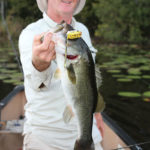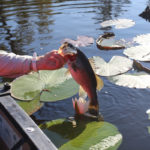
Frog lures will pull bass up through the heaviest vegetation and cover that develops as the weather heats up. Here’s how to fish them.
Bass fishing in June. Does it get any better? You hit your favorite fishing spot armed with crankbaits, spinnerbaits and buzzbaits; you’re ready to go on a spot you’ve been staying up nights dreaming about. You get there, and you’re surprised at how different it looks from a month ago. What the …. ? Lily pads! Weeds! Everywhere! Well, the crankbaits are useless here. Spinnerbaits, iffy. Topwater baits, out of the question.
But wait, you look deep in your tackle box and find a neglected, hollow-body frog. You’ve gotten your share of bites on it but never have landed a fish. You tie it on, cast it into the weeds, twitch it a few times and you hear what sounds like a toilet flushing as the frog disappears into a boil of water. You set the hook, the fish pulls back, and before you know it, your line is wrapped in a mess of weeds so heavy that you can’t tell if the fish is still on or not. You pull hard, trying to free your lure — and hopefully the fish — from the weeds. Maybe silently, maybe loudly, your line breaks, or you struggle to reel in some serious poundage of weeds on the end of your line with not a fish in sight.
Unfortunately, this happens too often for anglers fishing with frogs baits, but it doesn’t have to be this way. Frog fishing is a great way to land some lunkers this month, but anglers need to know a few tips to have success fishing these lures.
Ridgeway’s Brett Collins knows a few things about frog fishing. He catches his share of bass on these lures, and talks to other anglers who use these lures across the Carolinas while fishing in two tournament trails he runs: the Carolina Anglers Team Trail and the Carolinas Bass Classics. He said anglers need to use the right gear, fish in places most others wouldn’t and use brute force to fish with frogs.
“You can’t just cut your spinnerbait off that 12-pound test line on your medium-light rod with the low-speed reel. That’ll just leave you with torn up gear,” said Collins, who use a medium-heavy to heavy rod with a fast tip, and he likes the rod to be in the 6-foot-9 to 7-foot-6 range. “Sixty-pound braided line is the way to go. If a bass wraps you around a bunch of weeds or lily pads, he can get leverage to put a strain on the line, plus that stuff weighs a lot more than you think, especially when it’s soaking wet,” he said.
When it comes to reels, Collins said he wants a 7-to-1 speed reel or faster.
“You need heavy line to take the punishment of the weeds, a heavy rod for the same reason, and a fast reel to get the fish out of that slop as quickly as possible, he said.
Most anglers will throw a frog at the obvious weed patches along the shoreline, but many will bypass water that Collins said nobody should overlook.
“Really skinny creeks that look completely choked with weeds, or areas between dilapidated docks or downed timber — sometimes with a pocket of weed-infested water only as big as a coffee table — I’m throwing a frog there. If it looks impossible to get a lure there, a big fish has a comfortable home there, and he’s not used to seeing fake frogs. When I see a spot like that, I know I’m going to get bit there,” he said.
Collins is a big fan of Spro frogs, especially the popper version.
“There are other good brands out there. I look for a frog with a really soft body that is easy for the fish to crush, because if that body is too stiff, it will stop the hooks from penetrating the fish’s mouth. I also want a frog with really sharp hooks, and Spro’s frogs are sharp as can be right out of the package,” he said.
As far as technique goes, Collins casts into the weed patch, putting the frog as close to the bank as he can.
“I want it to look like that frog hopped off the land and onto that weed patch,” he said.
From there, Collins jerks the frog, pauses, reels in the slack, then repeats.
“When you get a bite, set the hook hard, then reel, reel, reel. This is why the heavy rod, heavy line and fast reel are necessary. Reel as fast as you can. Don’t give him a chance to wrap himself in the weeds,” he said.






Be the first to comment